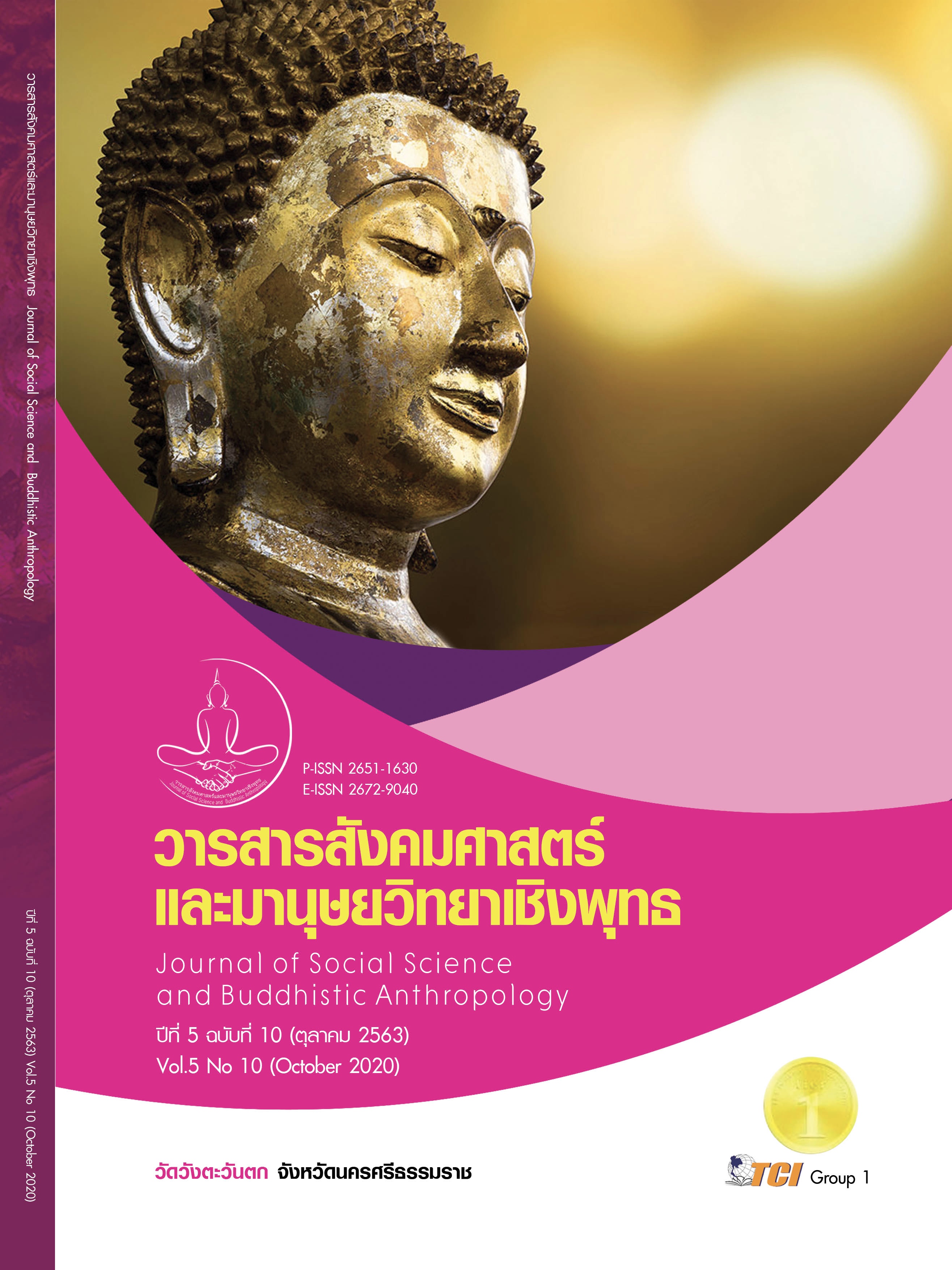DEVELOPMENT OF A FON JENG EXERCISE MODEL TO PROMOTE PHYSICAL FITNESS AND PSYCHOLOGICAL WELL - BEING AMONG COMMUNITY - DWELLING OLDER ADULTS WITH KNEE PAIN
Keywords:
A Fon Jeng Exercise, Physical Fitness, Psychological Well-Being, Osteoartitis KneeAbstract
The objectives of this research article were to develop and evaluate quality of a Fon Jeng Exercise Model to promote physical fitness and psychological well - being among community - dwelling older adults with knee pain using Participatory Action Research (PAR). There were two phases in the research procedure. Phase 1 was the development of a Fon Jeng Exercise Model process, including 1) investigating the situation of osteoarthritis of older adults in the research areas; 2) studying the concept of promoting physical fitness and psychological well - being of older adults with knee pain using a Fon Jeng exercise; 3) organizing a focus group discussion with the communities to analyze the causes and effects of osteoarthritis and to assess the community needs in preventing osteoarthritis using a Fon Jeng exercise 4) drafting a Fon Jeng exercise model. Phase 2 was the evaluation period of quality of a Fon Jeng exercise model. For assessing feasibility, the intervention was implemented with 10 older adults with knee pain three times per week at 50 - 60 min per practice session for two weeks. The outcome measures of weight, pulse rates, blood pressure levels, pain levels, and physical performance and psychological well-being were examined in before and after completing a Fon Jeng exercise program in two weeks using dependent sample t - test. The results revealed that a Fon Jeng exercise model consisted of three key stages and took 50 - 60 minutes to complete. The first stage was warming up which included 18 postures. The second stage was exercising which included 16 postures. The last stage was cooling down which included 12 postures. There was no significant different in any outcomes before and after completing the program (p - value>0.05). The overall older adults’ satisfaction scores with a Fon Jeng exercise program was a very high level ( = 4.74, SD. = 0.17).
References
กลุ่มฟื้นฟูสมรรถภาพสมอง (Train the Brain Forum Thailand). (2537). แบบวัดความซึมเศร้าในผู้สูงอายุไทย (Thai Geriatric Depression Scale: TGDS). สารศิริราช, 46(1), 1 - 9.
ฉลาด จันทรสมบัติ. (2554). การมีส่วนร่วมของชุมชนในการจัดการศึกษาเพื่อพัฒนาท้องถิ่น. (พิมพ์ครั้งที่ 3). มหาสารคาม: มหาวิทยาลัยมหาสารคาม.
พุทธิพงษ์ พลคำฮัก และคณะ. (2559). การพัฒนาการทดสอบลุกยืน 3 ครั้งแล้วเดินเพื่อใช้ทำนายความเสี่ยงต่อการล้มในผู้สูงอายุไทยในชุมชน. วารสารกายภาพบำบัด, 38(2), 48 - 58.
ไพรัช โกศัลย์พิพัฒน์. (2552). การพัฒนารูปแบบการออกกำลังกายแบบฟ้อนเจิงเพื่อส่งเสริมภาวะสุขภาพและสุขสมรรถนะของสตรีผู้สูงอายุ. ใน ดุษฎีนิพนธ์ครุศาสตรดุษฎีบัณฑิต สาขาพลศึกษา. จุฬาลงกรณ์มหาวิทยาลัย.
รังสิยา นารินทร์ และคณะ. (2558). การพัฒนาโปรแกรมดูแลผู้สูงอายุข้อเข่าเสื่อมโดยการมีส่วนร่วมของชุมชน. พยาบาลสาร, 42(3), 170 - 181.
วรรณดี สุทธิวรากร. (2556). การวิจัยเชิงปฏิบัติการ: การวิจัยเพื่อเสรีภาพและการสรรค์สร้าง. กรุงเทพมหานคร: สยามปริทัศน์.
วิลาวัลย์ ตันติพงศ์วิวัฒน์. (2553). ผลการออกกำลังกายแบบโนราบิคต่อความดันโลหิตและสมรรถภาคทางกายของผู้สูงอายุโรคความดันโลหิตสูง. ใน วิทยานิพนธ์พยาบาล ศาสตรมหาบัณฑิต สาขาวิชาพยาบาลศาสตร์. มหาวิทยาลัยสงขลานครินทร์.
ศุภาพร รัตนสิริ และคณะ. (2552). ผลของการออกกำลังกายแบบฟ้อนเจิงต่อสมรรถภาพทางกายในผู้สูงอายุ. วารสารพยาบาลสาร, 36(4), 21 - 34.
สนั่น ธรรมธิ. (2544). ฟ้อนเชิง สืบสานภูมิปัญญาล้านนา. (พิมพ์ครั้งที 1). เชียงใหม่: สันติภาพการพิมพ์.
สำนักงานหลักประกันสุขภาพแห่งชาติ. (2560). บอร์ดสปสช.ออกแนวปฏิบัติผ่าข้อเข่าเสื่อม กระจายอำนาจให้เขตช่วยผู้ป่วยเข้าถึงการรักษา. เรียกใช้เมื่อ 26 มิถุนายน 2561 จาก https://www.nhso.go.th/frontend/NewsInformationDetail.aspxnewsid=MjA0OQ==
สำนักนโยบายและยุทธศาสตร์ กระทรวง สาธารณสุข. (2558). สาระสุขภาพ (อินเตอร์เน็ต). เรียกใช้เมื่อ 7 พฤศจิกายน 2561 จาก http://wops.moph.go.th/ops/thp/thp/userfiles/file/Issue%2024_58.pdf.
แสงอรุณ ดังก้อง. (2560). กายภาพบำบัดในผู้ป่วยข้อเข่าเสื่อม. เวชบันทึกศิริราช, 10(2), 115 - 121.
อรพิน จุลมุสิ. (2551). ผลของการออกกำลังกายแบบฟ้อนเจิง มช. ต่อความดันโลหิตในผู้สูงอายุโรคความดันโลหิตสูง. พยาบาลสาร, 36(4), 46 - 58.
Agency for Healthcare Research and Quality (AHRQ). (2017). Treatment of osteoarthritis of knee: An update review. Retrieved June 27, 2018, from https://effectivehealthcare.ahrq.gov/sites/default/files/pdf/osteoarthritisknee-update_research-2017.pdf
American College of Sports Medicine. (2006). ACSM’guidelines for exercise testing and prescription. (7th ed.). Philadelphia: Lippincott Williams & Wilkins.
Bhatia, D. et al. (2013). Current interventions in the management of knee osteoarthritis. Journal of pharmacy & bioallied sciences, 5(1), 30 - 38.
Department of Health, Ministry of Public Health. (2015). Elderly health record. Bangkok: Suan Sunandha Rajabhat University.
Douka, S. et al. (2019). Traditional dance improves the physical fitness and well-being of the elderly. Aging Neuroscience, 11(2019), 1 - 9.
Edge, R. & Farrah, K. (2017). Exercise for the management of knee osteoarthritis: A review of clinical effectiveness. Retrieved June 25, 2018, from https://www.ncbi.nlm.nih.gov/books/NBK525040/
Graneheim, UH. & Lundman, B. (2004). Qualitative content analysis in nursing research: Concepts, procedures and measures to achieve trustworthiness. Nurse Education Today, 24(2), 105 - 112.
Guralnik, J. M. et al. (1994). A short physical performance battery assessing lower extremity function: Association with self-reported disability and prediction of mortality and nursing home admission. Journal of Gerontology, 49(2), M85 - M94.
Hsu, H. & Siwiec, R. M. (2020). Knee Osteoarthritis. Retrieved June 13, 2018, from https://www.ncbi.nlm.nih.gov/books/NBK507884/
Krejcie, R. V. & Morgan, D. W. (1970). Determining Sample Size for Research Activities. Educational and Psychological Measurement, 30(3), 607 - 610.
Loeser, R. F. (2017). The role of aging in the development of osteoarthritis. Transactions of the American Clinical and Climatological Association, 128(2017), 44 - 54.
Nik Shafii, N. et al. (2018). Traditional and complementary medicine use in knee osteoarthritis and its associated factors among patients in northeast peninsular Malaysia. Oman Medical Journal, 33(2), 148 - 153.
Reid, M. C. (2015). Management of chronic pain in older adults. Retrieved June 23, 2018, from https://www.bmj.com/content/350/bmj.h532/rapid-responses
Steinmeyer, J. et al. (2018). Pharmacological treatment of knee osteoarthritis: Special considerations of the new German guideline. Orthopedic reviews, 10(4), 77 - 82.
Tan, G. et al. (2004). Validation of the Brief Pain Inventory for chronic nonmalignant pain. The Journal of Pain: Official Journal of the American Pain Society, 5(2), 133 - 137.
Zhang, W. et al. (2019). Emerging trend in the pharmacotherapy of osteoarthritis. Frontiers in Endocrinology, 10(2019), 431 - 432.








